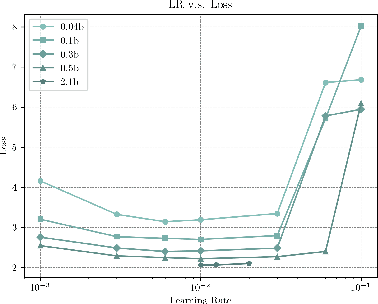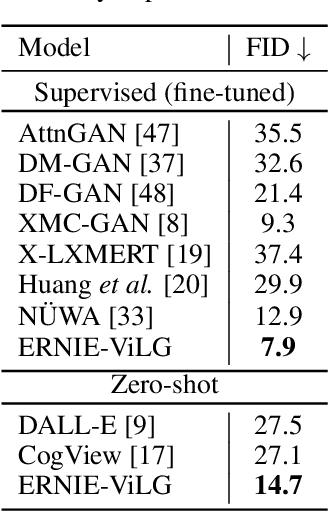Yewei Fang
MiniCPM4: Ultra-Efficient LLMs on End Devices
Jun 09, 2025Abstract:This paper introduces MiniCPM4, a highly efficient large language model (LLM) designed explicitly for end-side devices. We achieve this efficiency through systematic innovation in four key dimensions: model architecture, training data, training algorithms, and inference systems. Specifically, in terms of model architecture, we propose InfLLM v2, a trainable sparse attention mechanism that accelerates both prefilling and decoding phases for long-context processing. Regarding training data, we propose UltraClean, an efficient and accurate pre-training data filtering and generation strategy, and UltraChat v2, a comprehensive supervised fine-tuning dataset. These datasets enable satisfactory model performance to be achieved using just 8 trillion training tokens. Regarding training algorithms, we propose ModelTunnel v2 for efficient pre-training strategy search, and improve existing post-training methods by introducing chunk-wise rollout for load-balanced reinforcement learning and data-efficient tenary LLM, BitCPM. Regarding inference systems, we propose CPM.cu that integrates sparse attention, model quantization, and speculative sampling to achieve efficient prefilling and decoding. To meet diverse on-device requirements, MiniCPM4 is available in two versions, with 0.5B and 8B parameters, respectively. Sufficient evaluation results show that MiniCPM4 outperforms open-source models of similar size across multiple benchmarks, highlighting both its efficiency and effectiveness. Notably, MiniCPM4-8B demonstrates significant speed improvements over Qwen3-8B when processing long sequences. Through further adaptation, MiniCPM4 successfully powers diverse applications, including trustworthy survey generation and tool use with model context protocol, clearly showcasing its broad usability.
Ultra-FineWeb: Efficient Data Filtering and Verification for High-Quality LLM Training Data
May 08, 2025Abstract:Data quality has become a key factor in enhancing model performance with the rapid development of large language models (LLMs). Model-driven data filtering has increasingly become a primary approach for acquiring high-quality data. However, it still faces two main challenges: (1) the lack of an efficient data verification strategy makes it difficult to provide timely feedback on data quality; and (2) the selection of seed data for training classifiers lacks clear criteria and relies heavily on human expertise, introducing a degree of subjectivity. To address the first challenge, we introduce an efficient verification strategy that enables rapid evaluation of the impact of data on LLM training with minimal computational cost. To tackle the second challenge, we build upon the assumption that high-quality seed data is beneficial for LLM training, and by integrating the proposed verification strategy, we optimize the selection of positive and negative samples and propose an efficient data filtering pipeline. This pipeline not only improves filtering efficiency, classifier quality, and robustness, but also significantly reduces experimental and inference costs. In addition, to efficiently filter high-quality data, we employ a lightweight classifier based on fastText, and successfully apply the filtering pipeline to two widely-used pre-training corpora, FineWeb and Chinese FineWeb datasets, resulting in the creation of the higher-quality Ultra-FineWeb dataset. Ultra-FineWeb contains approximately 1 trillion English tokens and 120 billion Chinese tokens. Empirical results demonstrate that the LLMs trained on Ultra-FineWeb exhibit significant performance improvements across multiple benchmark tasks, validating the effectiveness of our pipeline in enhancing both data quality and training efficiency.
Tokenization Falling Short: The Curse of Tokenization
Jun 17, 2024Abstract:Language models typically tokenize raw text into sequences of subword identifiers from a predefined vocabulary, a process inherently sensitive to typographical errors, length variations, and largely oblivious to the internal structure of tokens-issues we term the curse of tokenization. In this study, we delve into these drawbacks and demonstrate that large language models (LLMs) remain susceptible to these problems. This study systematically investigates these challenges and their impact on LLMs through three critical research questions: (1) complex problem solving, (2) token structure probing, and (3) resilience to typographical variation. Our findings reveal that scaling model parameters can mitigate the issue of tokenization; however, LLMs still suffer from biases induced by typos and other text format variations. Our experiments show that subword regularization such as BPE-dropout can mitigate this issue. We will release our code and data to facilitate further research.
MiniCPM: Unveiling the Potential of Small Language Models with Scalable Training Strategies
Apr 09, 2024



Abstract:The burgeoning interest in developing Large Language Models (LLMs) with up to trillion parameters has been met with concerns regarding resource efficiency and practical expense, particularly given the immense cost of experimentation. This scenario underscores the importance of exploring the potential of Small Language Models (SLMs) as a resource-efficient alternative. In this context, we introduce MiniCPM, specifically the 1.2B and 2.4B non-embedding parameter variants, not only excel in their respective categories but also demonstrate capabilities on par with 7B-13B LLMs. While focusing on SLMs, our approach exhibits scalability in both model and data dimensions for future LLM research. Regarding model scaling, we employ extensive model wind tunnel experiments for stable and optimal scaling. For data scaling, we introduce a Warmup-Stable-Decay (WSD) learning rate scheduler (LRS), conducive to continuous training and domain adaptation. We present an in-depth analysis of the intriguing training dynamics that occurred in the WSD LRS. With WSD LRS, we are now able to efficiently study data-model scaling law without extensive retraining experiments on both axes of model and data, from which we derive the much higher compute optimal data-model ratio than Chinchilla Optimal. Additionally, we introduce MiniCPM family, including MiniCPM-DPO, MiniCPM-MoE and MiniCPM-128K, whose excellent performance further cementing MiniCPM's foundation in diverse SLM applications. MiniCPM models are available publicly at https://github.com/OpenBMB/MiniCPM .
ERNIE-ViLG 2.0: Improving Text-to-Image Diffusion Model with Knowledge-Enhanced Mixture-of-Denoising-Experts
Oct 27, 2022Abstract:Recent progress in diffusion models has revolutionized the popular technology of text-to-image generation. While existing approaches could produce photorealistic high-resolution images with text conditions, there are still several open problems to be solved, which limits the further improvement of image fidelity and text relevancy. In this paper, we propose ERNIE-ViLG 2.0, a large-scale Chinese text-to-image diffusion model, which progressively upgrades the quality of generated images~by: (1) incorporating fine-grained textual and visual knowledge of key elements in the scene, and (2) utilizing different denoising experts at different denoising stages. With the proposed mechanisms, ERNIE-ViLG 2.0 not only achieves the state-of-the-art on MS-COCO with zero-shot FID score of 6.75, but also significantly outperforms recent models in terms of image fidelity and image-text alignment, with side-by-side human evaluation on the bilingual prompt set ViLG-300.
ERNIE-ViLG: Unified Generative Pre-training for Bidirectional Vision-Language Generation
Dec 31, 2021



Abstract:Conventional methods for the image-text generation tasks mainly tackle the naturally bidirectional generation tasks separately, focusing on designing task-specific frameworks to improve the quality and fidelity of the generated samples. Recently, Vision-Language Pre-training models have greatly improved the performance of the image-to-text generation tasks, but large-scale pre-training models for text-to-image synthesis task are still under-developed. In this paper, we propose ERNIE-ViLG, a unified generative pre-training framework for bidirectional image-text generation with transformer model. Based on the image quantization models, we formulate both image generation and text generation as autoregressive generative tasks conditioned on the text/image input. The bidirectional image-text generative modeling eases the semantic alignments across vision and language. For the text-to-image generation process, we further propose an end-to-end training method to jointly learn the visual sequence generator and the image reconstructor. To explore the landscape of large-scale pre-training for bidirectional text-image generation, we train a 10-billion parameter ERNIE-ViLG model on a large-scale dataset of 145 million (Chinese) image-text pairs which achieves state-of-the-art performance for both text-to-image and image-to-text tasks, obtaining an FID of 7.9 on MS-COCO for text-to-image synthesis and best results on COCO-CN and AIC-ICC for image captioning.
 Add to Chrome
Add to Chrome Add to Firefox
Add to Firefox Add to Edge
Add to Edge